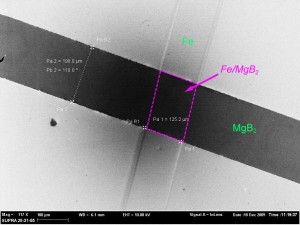Josephson Junction Development in Superconducting All-MgB2 Thin-film Vertical and Lateral Junctions

Figure 1: Electron microscope image of the weak-link region in a MgB2 thin film lateral device. The proximity of the Fe in the bilayer region of Fe/MgB2 causes local weakening or complete suppression of superconductivity, depending on the thickness of the MgB2 thin film.
MgB2 is a multi-gap superconductor with a TC of 39K and a hexagonal structure. This simple and stable compound is very attractive for device applications. We have developed thin-film all-MgB2 devices, both in the vertical geometry with a sputtered MgO barrier, and in the lateral geometry by creating weak-link junctions using proximity with Fe. In the first case, we have deposited and patterned micron-sized SIS tunnel junctions with highly textured MgB2 electrodes grown by MBE co-evaporation with sputter-deposited MgO tunnel barriers, in an entirely in-situ process. This method enabled us to obtain low-resistance junctions with very good oxide coverage. The I-V and dI/dV data display Josephson pair tunneling as well as the quasi-particle tunneling signature of both the Pi- and Sigma-bands of the MgB2, with gap values agreeing with previous reports. Although our MgB2 films were c-axis oriented, the growth-related roughness of the bottom MgB2 enabled a/b-axis tunneling, giving rise to Sigma-band features. The layers for lateral junctions were also deposited entirely in situ, the Fe film directly in contact with the MgB2 film, and these films were subsequently patterned into lateral bars. This configuration creates S1/U/S1 junctions, where U is the Fe/MgB2 bilayer region, and is either a weakened superconductor S2, or a normal metal N in the case where superconductivity is completely suppressed in the MgB2 thin film. Figure 1 is an electron microscope image of the weak link region in one of our typical devices. Current transport in these junctions is in the plane of the film, along the a/b-axis of the superconductor. We observe signs of pair tunneling through the weakened region.